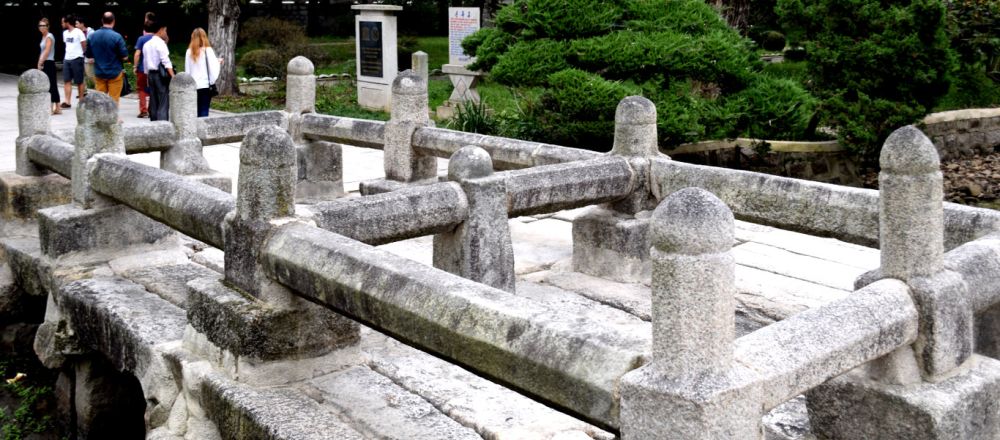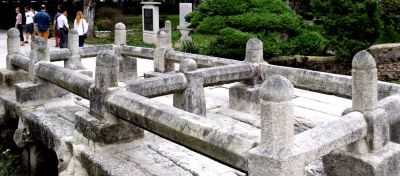

Explore the rich history of Kaesong and the famous Sonjuk Bridge with a knowledgeable tour guide. Sonjuk Bridge, also known as Sonji Bridge, is a small stone bridge dating back to the Goryeo Dynasty. It is a significant cultural landmark as the site of the assassination of a famous Korean scholar-official, Jeong Mong-ju, in 1392. The bridge is named after the bamboo that grew around the area. Take a step back in time as you traverse the bridge and learn about Jeong's loyalty to the Goryeo Dynasty, his tragic death, and its impact on Korean history. Understand the bridge's role as a UNESCO World Heritage Site and its importance to the Korean people. This guided tour provides historical context to the site and will be rich in stories, taking you through the complex history of the Korean peninsula.
After visiting Sonjuk Bridge, make your way to the close-by Koryo Museum. This museum is housed in the old Confucian university of the Koryo Dynasty and showcases various artefacts and relics from that era. With over a thousand years of history, the Koryo Museum provides a deep insight into the culture, art, and history of the Koryo Dynasty, which ruled Korea from 918 to 1392. You'll see ancient printing blocks, traditional Koryo celadon pottery, and intricate Buddhist sculptures. The surrounding garden also features several Goryeo-era steles and pagodas, which provide a peaceful place to reflect upon the ancient history you'll be learning about.
Take a tour around Kaesong to visit the Royal Tombs of the Koryo Dynasty. These well-preserved tombs offer a glimpse into the funerary practices and beliefs of ancient Korea. Each tomb is unique, with stone sculptures and intricately decorated burial mounds. As you walk through the area, you'll learn about the individual kings and royals who are buried here, their contributions to the dynasty, and how their legacies shaped the history of Korea. These tombs are also part of the UNESCO World Heritage Sites and are an essential visit for anyone interested in ancient history and archaeology.
Although located a distance from Sonjuk Bridge, a trip to the Demilitarized Zone (DMZ) at Panmunjom is a powerful and sobering experience. It provides visitors with a unique insight into the tensions between North and South Korea. You will explore various sites including the Joint Security Area (JSA), where negotiations between North and South have taken place. Hear stories from your guide about the history of the Korean War, ongoing military confrontations, and hopes for future peace. This tour often requires passport details in advance and compliance with strict dress codes and behavior protocols due to the sensitive nature of the area.
Stroll through the streets of Kaesong's Old Town to see well-preserved architectural styles that showcase what a traditional Korean town once looked like. The area is a beautiful example of Korean urban planning and housing from centuries past, with its small alleyways, traditional Hanok houses, and the layout of the town itself, which in many ways, reflects the social hierarchies of the time. You'll likely see local vendors, historical monuments, and can even stop to try some local Korean delicacies being sold from the street stalls. Walking around old town is a wonderful way to immerse yourself in the history of the region at your own pace.
Dive into the flavors of traditional Korean cuisine with a culinary experience in Kaesong. Restaurants in the city are known for their authentic Korean dishes, including the local specialty, Kaesong Koryo insam chicken soup, reputed for its medicinal properties. The meal would typically include a variety of banchan (side dishes), kimchi, and other seasonal ingredients prepared using traditional techniques. A culinary experience in Kaesong is more than just eating; it's about understanding the culture and history behind the food. The experience might include an introduction to traditional Korean dining etiquette and might even be set in an atmospheric, historic building.
Explore the ruins of Manwoldae Palace, the main royal palace during the Koryo Dynasty. Although the palace was destroyed during the wars, the site has been excavated, and visitors can see the foundations and layout of this once-massive complex. The grounds are vast and offer peaceful areas for visitors to enjoy. Informational signs around the site provide historical context to what you're seeing. The visit is particularly recommended for those interested in architecture and the dynastic history of Korea.
Janamsan Park is located just outside of Kaesong and is a perfect spot for a short hike and to enjoy panoramic views of the city and surrounding countryside. The journey to the peak is relatively easy, making it accessible for casual hikers. You'll pass by local flora and might catch a glimpse of regional wildlife. At the top, take a moment to breathe in the fresh air and snap some memorable photos of the apparently untouched landscape. This activity is an ideal escape from the historical tours and gives you a chance to relax in nature.
For a unique and somewhat quirky experience, visit the stamp shop in Kaesong. North Korean philately offers an exciting window into the propaganda and iconography of the country, with stamps being a popular collectible item among tourists. The shop offers a variety of stamps, postcards, and even coins and banknotes. This is more than just a shopping trip; it's a way to observe and perhaps better understand the culture of North Korea through its stamps. You'll find depictions of North Korean successes, important figures, and key moments in DPRK history.
Participate in a workshop where you’ll learn the traditional Korean craft of making Hanji paper, which is made from the mulberry tree and is known for its durability and versatility. The process involves a number of steps, from pulping the fibers to drying the sheets, and you'll get to be hands-on through the whole process. At the end of the experience, you can take home your own handmade paper or traditional objects crafted from it. Local artisans conduct these workshops and provide insight into the importance of Hanji in Korean culture, from its use in books and art to its role in everyday life.
